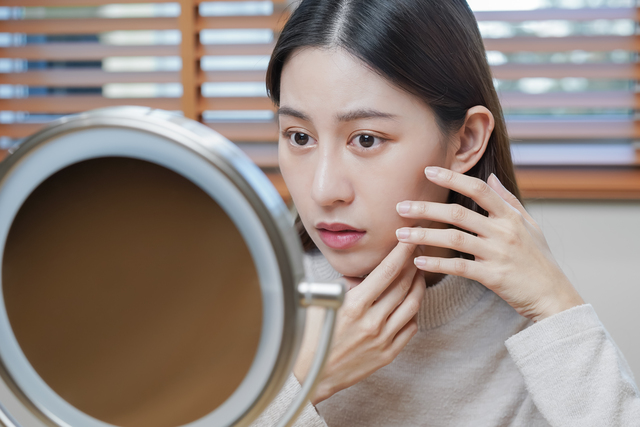Introduction
Skin’s dark spots, commonly referred to as hyperpigmentation, emerge as a prevalent concern bridging the realms of health and cosmetics.
This pervasive issue, marked by the uneven distribution of melanin. The pigment responsible for skin color—sparks a quest for solutions among individuals aiming to address both aesthetic and well-being considerations.

In the following paragraphs, we will dissect the intricate facets of skin’s dark spots, unraveling their causes, exploring their impacts, delving into available treatment options, and shedding light on preventive measures that pave the way for healthier skin.
Understanding the Basics: Skin’s Dark Spots and Their Impact
Factors that contribute to hyperpigmentation
To comprehend the genesis of the skin’s dark spots, one must first scrutinize the diverse array of factors that contribute to hyperpigmentation.
Prolonged exposure to ultraviolet (UV) radiation stands out as a primary catalyst, stimulating melanin production and leaving lasting imprints on the skin.
Hormonal fluctuations, a common occurrence during pregnancy or due to certain medications, further complicate this phenomenon.
Additionally, scars from injuries or inflammatory skin conditions can evolve into persistent dark spots, underscoring the multifaceted nature of this dermatological concern.
Is the Skin’s Dark Spots a Health Issues?
Beyond the aesthetic implications, this disease wield significance in the broader spectrum of health and well-being. These pigmentation irregularities serve as more than mere blemishes, potentially signaling underlying health issues.
Distinguishing between benign hyperpigmentation and conditions requiring medical attention becomes paramount. Emphasizing the need for a holistic understanding of the impact of dark spots on one’s overall health.
This dual perspective bridging the cosmetic and health domains—forms the foundation for a comprehensive exploration of the topic at hand.
Understanding the Basics of skin’s dark spots
As we navigate the intricacies of skin’s dark spots, we will unravel not only the causes and health implications but also the spectrum of available solutions. Treatment modalities, ranging from over-the-counter remedies to advanced dermatological procedures, offer a diverse toolkit for individuals seeking to address hyperpigmentation.
Simultaneously, proactive measures take center stage in preventing the onset of these dark spots, emphasizing the importance of sun protection, skincare routines, and a nuanced approach to maintaining skin health.
In the subsequent discourse, we will navigate this expansive landscape to empower readers with insights that extend beyond cosmetic concerns, fostering a holistic approach to understanding and managing skin’s dark spots.
Causes of Skin’s Dark Spots
1. Excess Melanin Production
Melanin, the pigment responsible for the diverse hues of human skin, assumes a central role in the occurrence of dark spots. While this pigment is crucial for determining an individual’s skin color, an overproduction of melanin can result in the manifestation of unsightly dark spots.
Several factors contribute to the escalation of melanin production, ultimately leading to the formation of dark spots. Prolonged exposure to ultraviolet (UV) radiation from the sun stands as a primary external culprit, stimulating melanocytes—the cells responsible for melanin synthesis.
Hormonal changes, such as those occurring during pregnancy or as a side effect of certain medications, further exacerbate this process. Internal factors, including inflammatory skin conditions and the aftermath of injuries, also play a role in disrupting the delicate balance of melanin production.
2. Sun Exposure and Sunspots
Prolonged exposure to ultraviolet (UV) rays emerges as a chief protagonist in the narrative of the skin’s dark spots, fostering the development of sunspots. These spots, also known as solar lentigines or age spots, materialize as a consequence of the skin’s response to chronic sun exposure.
The sun’s ultraviolet rays prompt an increase in melanin production, the pigment responsible for skin color, as a defense mechanism. Over time, this defensive response can result in the uneven distribution of melanin, culminating in the formation of sunspots.
Sunspots, often appearing as flat, brown, or black spots on the skin, serve as visible reminders of the impact of prolonged sun exposure. The face, hands, shoulders, and other areas frequently exposed to sunlight bear the brunt of these dark spots.
Beyond their aesthetic implications, sunspots signify an intricate interplay between the skin and the sun’s rays. Understanding this relationship is crucial for individuals aiming to mitigate the development of sunspots and cultivate a skin-care routine that addresses the repercussions of extended UV exposure.
3. Hormonal Changes and Melasma
Skin’s dark spots often find their roots in hormonal fluctuations, a phenomenon notably observed during pregnancy or as a consequence of certain medical conditions. Melasma, a condition triggered by hormonal shifts, manifests as the development of dark patches on the skin.
This intricate interplay between hormones and pigmentation is particularly pronounced in pregnant individuals due to elevated levels of estrogen and progesterone, which can stimulate the overproduction of melanin.
Similarly, individuals grappling with hormonal imbalances stemming from medical conditions may also experience the emergence of melasma, accentuating the diverse pathways through which skin’s dark spots can materialize.
4. Skin Injuries and Dark Marks
The aftermath of skin injuries, whether from acne breakouts or inflammatory conditions, can often leave a lasting imprint in the form of dark marks. These marks, contributing to the broader landscape of skin’s dark spots, serve as tangible reminders of the skin’s remarkable ability to respond to trauma.
Acne, a common skin condition, can lead to post-inflammatory hyperpigmentation, where the healing process leaves behind darkened areas. Similarly, other forms of skin inflammation contribute to the intricate tapestry of dark spots, emphasizing the diverse pathways through which skin responds to injury.
Understanding the connection between skin injuries and the subsequent development of dark spots is paramount for devising effective treatment strategies. Recognizing that these spots are not solely cosmetic concerns but indicative of the skin’s reparative processes opens avenues for targeted interventions.
Impact on Skin Health
The repercussions of skin’s dark spots extend beyond mere cosmetic considerations, delving into the realm of psychological well-being. Individuals grappling with these pigmentation irregularities may find themselves contending with psychological distress, as changes in skin appearance can significantly influence self-esteem and body image.
The visible nature of dark spots, whether caused by sun exposure, hormonal fluctuations, or skin injuries, can evoke a range of emotions, from self-consciousness to anxiety. Acknowledging the psychological impact underscores the importance of addressing skin’s dark spots not only for aesthetic reasons but also for nurturing mental and emotional health.
Moreover, untreated skin discoloration carries potential health implications, emphasizing the necessity of a comprehensive approach to care. Dark spots can sometimes be indicative of underlying health issues, necessitating attention beyond cosmetic interventions.
Treatment Options for Skin’s Dark Spots

1. Topical Treatments with Hydroquinone or Retinoids
Addressing skin’s dark spots often involves the strategic application of topical treatments, with hydroquinone and retinoids emerging as potent ingredients in this realm. Over-the-counter and prescription creams formulated with these compounds have demonstrated efficacy in lightening dark spots by interfering with the melanin production process.
Hydroquinone, a common skin-lightening agent, works by inhibiting the activity of melanocytes—the cells responsible for melanin synthesis. This hindrance in melanin production leads to a gradual reduction in the intensity of dark spots, promoting a more even skin tone.
Retinoids, derivatives of vitamin A, also play a crucial role in the treatment of skin’s dark spots. These compounds enhance skin cell turnover, facilitating the shedding of pigmented cells and promoting the growth of new, evenly pigmented skin.
The combined effect of hydroquinone and retinoids in topical treatments offers a targeted approach to combat hyperpigmentation, providing individuals with a viable means to address the visible signs of skin’s dark spots and attain a more radiant complexion.
2. Chemical Peels for Reducing Skin Discoloration
In the pursuit of mitigating skin’s dark spots, chemical peels stand out as a transformative option. This dermatological procedure involves the application of a chemical solution to the skin, inducing controlled exfoliation and the removal of the outermost layer.
The targeted action of chemical peels extends beyond mere exfoliation, actively reducing skin discoloration by addressing hyperpigmentation. As the outer layer of the skin is shed, the darkened areas associated with hyperpigmentation are gradually diminished, revealing a fresher, more evenly pigmented skin beneath.
The effectiveness of chemical peels in reducing skin discoloration is attributed to their ability to accelerate cell turnover, promoting the regeneration of healthier skin. This process is particularly beneficial for individuals dealing with the aftermath of skin injuries, acne-related pigmentation, or other forms of hyperpigmentation.
The controlled nature of chemical peels, administered under professional guidance, allows for a tailored approach to address specific concerns related to skin’s dark spots. As a result, individuals seeking a rejuvenated and more uniform skin tone can consider chemical peels as a viable option in their skincare journey.
3. Laser Therapy Targeting Specific Layers for Dark Spot Reduction
In the realm of cutting-edge skincare, laser therapy emerges as a precise and effective solution for reducing skin’s dark spots. This advanced treatment modality operates by directing concentrated beams of light onto specific layers of the skin, where hyperpigmentation is prevalent.
The targeted nature of laser therapy allows for the selective breakdown of pigmented cells, minimizing the appearance of dark spots. This focused approach is particularly advantageous in addressing stubborn pigmentation issues that may not respond as effectively to other treatments.
It is crucial to emphasize that laser treatments for dark spot reduction should be administered under the guidance of a qualified dermatologist. The expertise of a professional ensures the accurate calibration of the laser, tailored to an individual’s skin type and the specific characteristics of their dark spots.
Additionally, the supervision of a dermatologist ensures that the procedure is conducted safely, minimizing the risk of adverse effects. Laser therapy, when employed judiciously and with expert oversight, represents a sophisticated avenue for individuals seeking targeted and long-lasting reduction of skin’s dark spots.
The importance of Sun Protection

For individuals grappling with skin’s dark spots, maintaining a regimen of consistent sun protection is paramount. The harmful effects of ultraviolet (UV) rays exacerbate hyperpigmentation, making the diligent application of sunscreen a foundational element in mitigating the darkening of existing spots and preventing the formation of new ones.
Sunscreen, with a broad-spectrum formulation, acts as a protective shield, creating a barrier against the damaging effects of both UVA and UVB rays. Additionally, complementing sunscreen use with protective clothing, such as wide-brimmed hats and long-sleeved garments, further fortifies this preventive strategy, minimizing the exposure that can lead to the aggravation of skin’s dark spots.
This proactive approach to sun protection gains heightened significance for individuals undergoing treatments to address their skin’s dark spots. Whether opting for topical solutions, dermatological procedures, or other therapeutic modalities, the susceptibility of treated skin to UV damage underscores the need for rigorous sun protection.
Consistency in these preventive measures not only safeguards the progress made in dark spot reduction but also fosters an environment conducive to the overall health and resilience of the skin. In the pursuit of skin clarity, the integration of sun protection becomes an indispensable component, empowering individuals to actively participate in the management and prevention of their skin’s dark spots.
Conclusion
Skin injuries, encompassing the aftermath of acne breakouts or inflammatory conditions, add another layer to the complexity of dark spot formation. Understanding this diverse landscape of causative factors is fundamental for individuals seeking comprehensive insights into the origins of their skin’s dark spots.
In essence, the journey to address skin’s dark spots encompasses not only cosmetic aspirations but extends to the realm of holistic health goals. By recognizing the interconnectedness of aesthetic concerns with overall well-being, individuals can embark on a proactive and informed approach.
Embracing a comprehensive strategy that combines tailored treatments with diligent sun protection empowers individuals to take charge of their skin health. Through this dual commitment to both cosmetic and health objectives, the narrative of skin’s dark spots transforms from a challenge to an opportunity for informed self-care.
FAQs
1. Q: Can skin’s dark spots be completely cured?
While a complete cure may not always be possible, various treatments can significantly reduce the appearance of the skin’s dark spots.
2. Q: How long does it take to see results from topical treatments for the skin’s dark spots?
Results vary, but improvement is often noticeable within a few weeks to months of consistent use.
3. Q: Are laser treatments safe for all skin types when addressing the skin’s dark spots?
Laser treatments should be performed by qualified professionals, considering individual skin types and conditions for safety.
4. Q: Can skin’s dark spots be entirely prevented?
While prevention is challenging, sun protection measures can significantly reduce the risk of developing new dark spots.
5. Q: Are there natural remedies for the skin’s dark spots?
Some natural ingredients, like vitamin C and licorice extract, may help lighten skin’s dark spots, but results vary.







